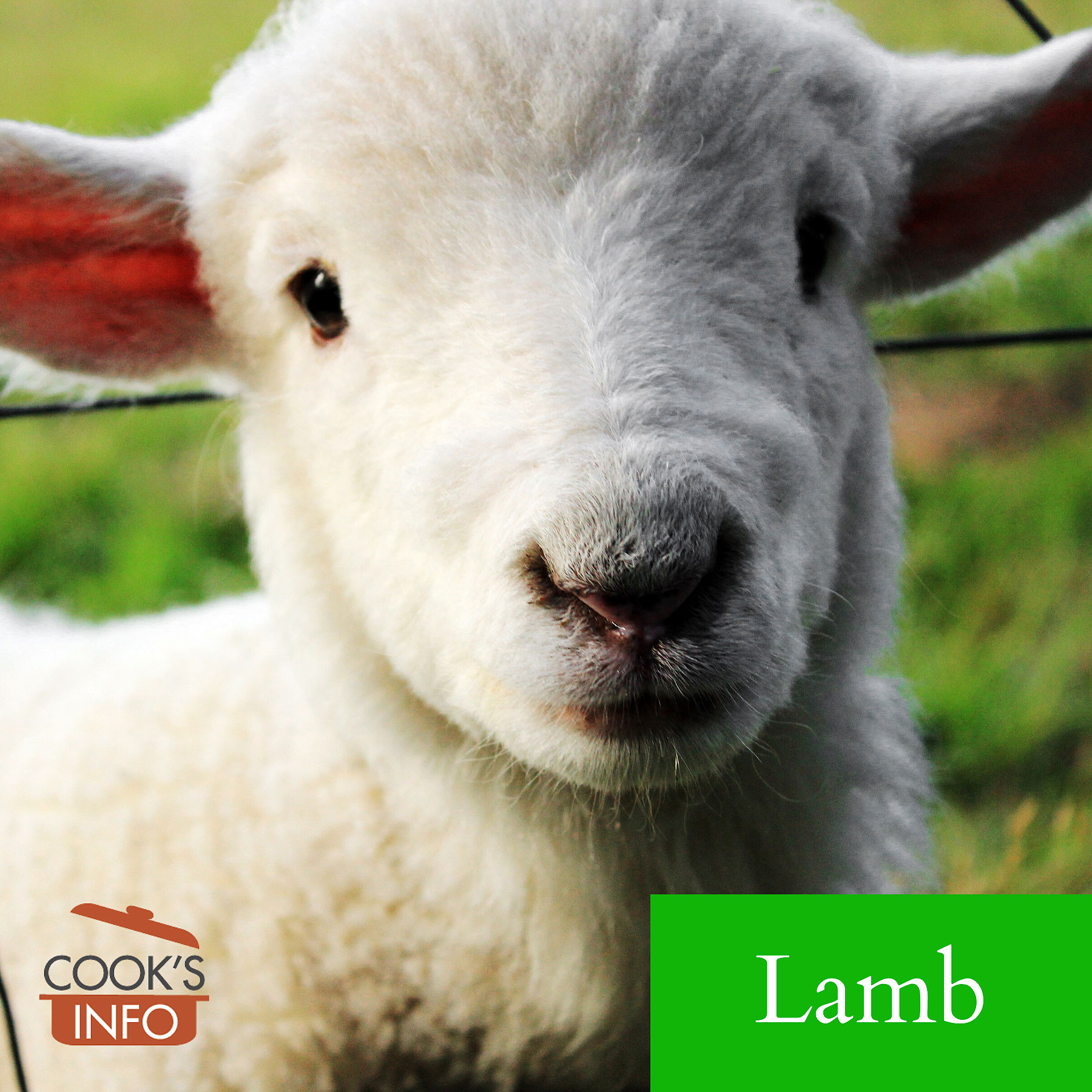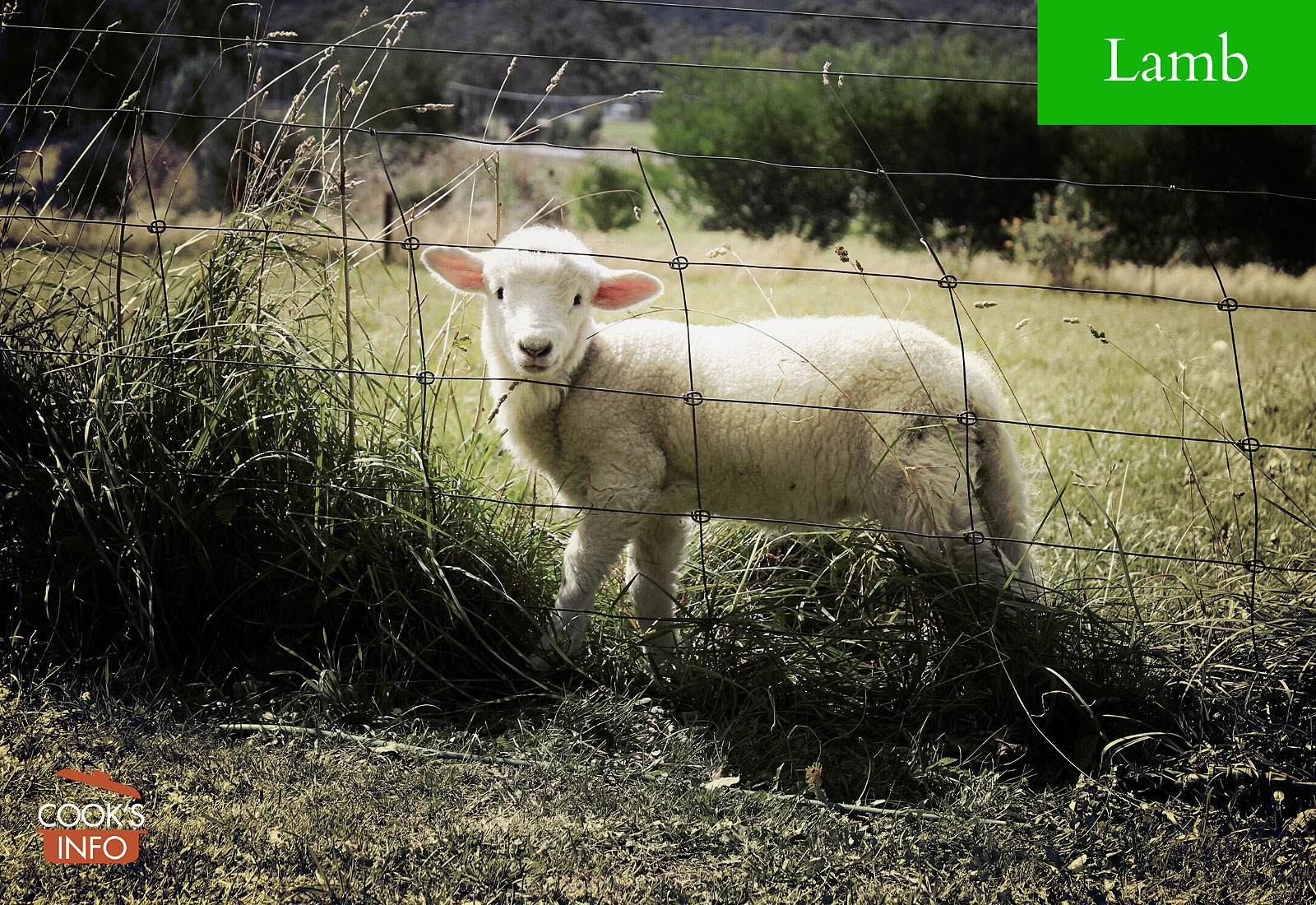
Benjamin Nelan / pixabay.com / 2012 / CC0 1.0
Lambs are the off-spring of sheep. The meat from lamb has a milder taste than that from grown sheep.
Sheep bear lambs in early spring. The lambs drink mother’s milk up for three to four weeks, at which time they then start on grass and start to increase in size.
Some say that Easter, when it is traditional to serve lamb, is actually too early for good tasting lamb, as they haven’t had enough time in pasture yet to eat grass and forage. Others say that when lambs start to graze, the flavour gets strong.
Lamb is usually sold for meat by August / September.
Lamb from New Zealand used to always be brought north by ship, frozen. Now fresh is brought up by plane.
Many people do not like the taste of lamb fat.
- 1 Types of lamb
- 2 Lamb cuts
- 3 Cooking Tips
- 4 Lamb consumption in the United States
- 5 History Notes
- 6 Language Notes
-
7
Sources
- 7.1 Agneau d'herbe
- 7.2 Agneau de Bergerie
- 7.3 Agneau de Boucherie
- 7.4 Agneau de Lait des Pyrénées
- 7.5 Barnsley Chops
- 7.6 Baron of Lamb
- 7.7 Carré of Lamb
- 7.8 Ground Lamb
- 7.9 Lamb Fell
- 7.10 Lamb Fore End
- 7.11 Lamb Hind End
- 7.12 Lamb Middle
- 7.13 Lamb Ribs
- 7.14 Lamb Shoulder
- 7.15 Lamb Tongue
- 7.16 Lamb's Fry
- 7.17 Paillard of Lamb
- 7.18 Pauillac Lamb
- 7.19 Pavé of Lamb
- 7.20 Salt Marsh Lamb
- 7.21 Scottadito
- 7.22 Sisteron Lamb
- 7.23 Stewing Lamb
- 7.24 Suckling Lamb
Types of lamb
- Hot house lamb: up to 2 weeks old. Will weigh 4.5 to 5.5 kg (10 to 12 pounds);
- Baby lamb: 4 to 6 weeks old, 7 to 9 kg (15 to 20 pounds);
- Abbachio: Italian term for lamb between 20 and 30 days old, weighing between 5 to 10 kg (10 and 20 pounds);
- Agnellone: Italian term for a lamb over 18 kg (40 pounds);
- Spring lamb: not really an indication of season any more, more an indication of age — 3 to 5 months old;
- Suckling lamb.
Lamb cuts
When a lamb is young, its bones will be pink. As it gets older they will turn white. The meat also turns from a brownish red to a cherry red.
The carcass weight will be about 50% of live weight. Of the carcass weight, 70% will be retail cuts, 30% will be fat and bone. Lamb is aged like beef to increase its tenderness and flavour. It needs to be hung at least a week.
Baby lamb is usually sold whole, halved or quartered. Only when it’s older will a butcher usually attempt traditional cuts.
Lamb can be divided into roughly 3 areas of the animal: Lamb Fore End, Lamb Middle and Lamb Hind End. Or more precisely, working backwards from the neck of the lamb, the shoulder section comes first, then the rib section, then the loin, then the rump (aka chump.)
Choose one of the following for a full-size cut chart:
In the US, the neck is either included in with the Shoulder Primal Cut, or it is just processed as slices called “Neck Slices.” It is harder to sell cuts labelled as “neck” in the US.
In the UK, 2 different cuts are made with the neck: Scrag End, and the other called “Middle Neck” or just “Neck.”
The cut called “shoulder” in the US is divided in the UK into two cuts: “scrag” at the very top, and below that, “shoulder middle neck.”
The cut called “sirloin” in the US is called “chump” in the UK.
The rear leg, one entire cut in the US, is divided in the UK into “fillet end of leg” at the top, and “shank end of leg” below that.
Cooking Tips
Let lamb come to just room temperature before roasting.
Cook to 60 C (140 F); let rest to 63 C (145 F.)
For a savoury lamb roast, make slits in the lamb you are going to roast, and press an anchovy fillet in each slit along with some garlic slices and rosemary.
To roast large joints of lamb: heat oven to 230 C (450 F.) Cook joint for 15 minutes so that the centre gets heated, then reduce heat to 200 C (400 F) and roast at this temperature for the following times according to desired doneness:
- Rare: 13 minutes per kg (2 pounds)
- Medium: 18 minutes per 500 g (pound);
- Well-done: 20 to 22 minutes per 500 g (pound).
Roast smaller joints at 230 C (450 F) for the whole time.
Generally, people don’t make gravy with lamb as is too fatty. That’s why it was traditionally served with mint sauce. To make gravy for lamb, you generally need to start from a previously prepared lamb stock, or have had time to set the “jus” in the fridge, to allow every last bit of the fat to congeal to the top to be removed and discarded.
To braise lamb, brown it first in a frying pan. Don’t trim away all the fat, as the fat will help to stop the meat from drying out during this. Lamb cooks faster by braising than many other meats — check it after 45 minutes.
Lamb barbeques very well because of the fat marbling it has. Season lamb pieces with pepper, rub with oil. Allow 3 to 4 minutes per side for medium, 5 minutes per side for well-done.
Lamb consumption in the United States
Americans were not big fans of lamb in the second half of the 1900s.
“Americans who served in Europe during World War II were fed canned mutton, which they disliked because of its strong musky flavor. Many of the soldiers, when they returned home after the war, banned lamb meat from dinner tables – contributing to a long decline in U.S. lamb consumption.
American ate 7.3 pounds of lamb and mutton per capita in 1945. That fell steadily to 1.4 pounds in 1990 and then to 0.85 pounds per capita in 2011. After the rebound that began in 2012, Americans ate 1.1 pounds of lamb per capita in 2017. Even with the increase, lamb consumption is small in comparison to the 57 pounds of beef and 92 pounds of chicken that Americans ate per capita last year.” [1]Knutson, Jonathan. Good news for lamb producers: Demand for lamb grows. Fargo, North Dakota. AgWeek. 7th May 2018.
History Notes
Lamb was often reserved for sale at the market; the family and the poorer people would eat pork.
Some Greek and Roman writers believed that the wind direction could influence the sex of the lamb being conceived:
“Some writers told… stories about … the wind’s responsibility for the sex of the lamb. The second century writer Aelian wrote in his On the Characteristics of Animals (2.48) that sheep who were being impregnated by a ram would conceive male lambs if there was a north wind and female lambs if there was a south wind.” [2]King, Helen. Wind eggs and the uterine mole. Module 5, 1.1. Health and Well-being in the Ancient World. Open University. Accessed May 2020 at https://www.open.edu/openlearn/ocw/mod/oucontent/view.php?id=65962§ion=1.1
Language Notes
Very young lamb is called in Italian “abbacchio.”
Sucking lamb is “agneau de lait” in French, “Milchlamm” in German and “cría de cordero” in Spanish.
Sources
Dupree, Nathalie. Luscious Lamb. Charleston, South Carolina: The Charleston Post and Courier. 23 March 2005.

Benjamin Nelan / pixabay.com / 2012 / CC0 1.0
Agneau d'herbe
Agneau de Bergerie
Agneau de Boucherie
Agneau de Lait des Pyrénées
Barnsley Chops
Baron of Lamb
Carré of Lamb
Ground Lamb
Lamb Fell
Lamb Fore End
Lamb Hind End
Lamb Middle
Lamb Ribs
Lamb Shoulder
Lamb Tongue
Lamb's Fry
Paillard of Lamb
Pauillac Lamb
Pavé of Lamb
Salt Marsh Lamb
Scottadito
Sisteron Lamb
Stewing Lamb
Suckling Lamb
References
| ↑1 | Knutson, Jonathan. Good news for lamb producers: Demand for lamb grows. Fargo, North Dakota. AgWeek. 7th May 2018. |
|---|---|
| ↑2 | King, Helen. Wind eggs and the uterine mole. Module 5, 1.1. Health and Well-being in the Ancient World. Open University. Accessed May 2020 at https://www.open.edu/openlearn/ocw/mod/oucontent/view.php?id=65962§ion=1.1 |

